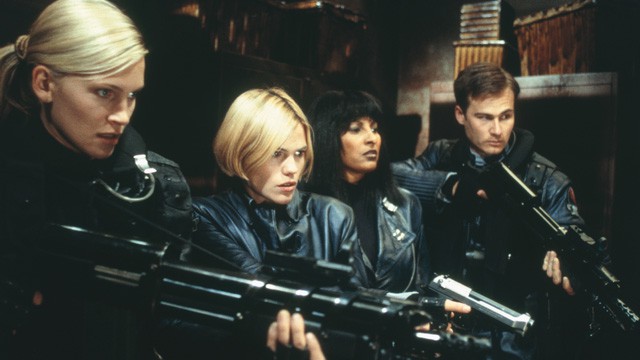For the first two installments in this series, I tried to dig apart some of the thematic issues at the heart of science-fiction horror films. But beyond Alien, the subgenre has such a poor reputation that most entries in it aren’t worthy of too much serious consideration. Few horror auteurs ever try their hand at sci-fi horror crossover, and when they do, the results are often mixed.
Unfortunately, the penultimate film from horror master John Carpenter, 2001’s Ghosts of Mars, falls into this second category. But that doesn’t mean we shouldn’t give it our attention; in fact, the film deserves a few words written about it simply because it’s so down-right bizarre. Basically, Ghosts of Mars is an outer space western set on a post-colonial Mars (actually a salt mine in New Mexico dyed with food coloring) in which wanted criminal Desolation Williams (Ice Cube, doing his best Snake Plissken) and the police officer sent to retrieve him, Lieutenant Melanie Ballard (Natasha Henstridge) team up to battle an army of self-mutilating Hellraiser extras led by an unintelligible Martian Marilyn Manson impersonator. The film’s hordes of villains were once human miners, but Martian ghosts out to get revenge against their oppressors have possessed their bodies and turned them into something less than human.
When I say that Ice Cube evokes Snake Plissken, I’m not just comparing two very similarly-dressed men; John Carpenter literally intended for Ghosts of Mars to be another Plissken film. But after the box office failure of Escape from L.A., Screen Gems wanted nothing to do with everyone’s favorite eye-patched ex-Special Forces operative. Carpenter changed the character’s name to “Desolation Williams” and accepted the studio’s one other condition: Ice Cube had to play the part. Carpenter originally had a young Jason Statham in mind, but Statham found himself demoted to the role of Sergeant Jericho, a horny cop who, despite his many attempts to change her mind, just doesn’t seem to understand that Ballard has absolutely no sexual interest in him. In fact, none of the women on this planet do; for some inexplicable reason, the film insinuates that every single woman on Mars is a lesbian. The planet has a matriarchal society, which could allow the film to discuss gender on a serious level, but it never drills beneath the subject’s surface. In fact, Ghosts of Mars passes up several opportunities to delve into deeper issues. The titular ghosts’ primary motivation to drive out their planet’s new inhabitants seems to be revenge for the settlement and destruction of the red planet, which raises a few interesting questions about imperialism, but ultimately, Ghosts of Mars is as much about colonialism as Chicken Run is about animal rights.
To its detriment, it also happens to be a film very much of its time; no one would dare make Ghosts of Mars in any year but 2001. The possessed miners build grotesque sculptures out of scissors and barbed wire that look like something you’d find in a bizarro, industrial version of The Blair Witch Project. John Carpenter does his usual soundtrack duties, but this time Anthrax and Buckethead assist. The film’s obsession with self-mutilation feels distinctly post-Columbine, and I’m not kidding when I say that the nameless, babbling villain belongs in the music video for “The Beautiful People.”
But maybe I’m not giving this film the credit it deserves. It looks much cheaper than its $28 million budget would suggest, as the whole thing feels held together by chicken wire, bailing twine, and epoxy glue, like a science fair diorama haunted by the ghost of your kid brother who died from accidentally huffing too much rubber cement. This inexpensive-appearing visual aesthetic makes the film feel claustrophobic and isolated in a way that sets the tone for later genre films like Paul W.S. Anderson’s Resident Evil: Retribution. But that cheap look, along with the film’s numerous decapitations, weird wire sculptures, and brutal violence, could be the point. Perhaps what’s so unsettling about Ghosts of Mars is that, despite its budget, it’s a legitimate grindhouse film. It’s not an homage to exploitation movies, as we’re so used to in the 21st century, but the real deal and from one of the masters of American genre cinema to boot. There are no digital scratches or burns added to make it look like “real” film stock, no references to Romero or Russ Meyer, no Morricone on the beat. It’s just a good old-fashioned gun-slinging time, albeit appropriately jacked up for audiences in the 20XX era. In that regard, it’s “fun,” but it’s so dated to 2001 that it might be a few more years before we have enough nostalgia for the new millennium to watch it without cringing.
As John Carpenter’s penultimate film, it’s also a bit depressing to watch. He’s one of the great auteurs not just of horror and science fiction films, but of all cinema, and it’s sad to see him not able to achieve his full vision. I pray that changes and he makes another one. However, it’s important not to take something like Ghosts of Mars too seriously; there’s definitely delight to be had in watching Ice Cube break the fourth wall while he holds a chrome machine gun. Or if gore’s more your speed, you might enjoy seeing Pam Grier’s head on a stake. It’s not an incompetent film, it’s just something we don’t often see much of in genre cinema in the 2000s. It’s an entirely unpretentious affair: imaginative, absurd, and unadorned.









